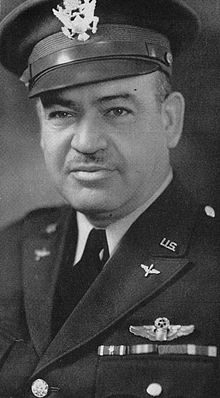Caleb Vance Haynes (March 15, 1895[3] – April 5, 1966) was a United States Air Force (USAF) major general. The grandson of Chang Bunker, a famous Siamese Twin, he served in the Air Force as an organizer, able to create air units from scratch. He commanded a large number of groups, squadrons and task forces before, during and after World War II.[1]
In the 1930s, Haynes, a rated command pilot, led experimental long-range over-water interception flights that were key to the development of U.S. air defense doctrine. Haynes demonstrated by piloting one of the bombers that intercepted the Italian liner SS Rex that enemy ships could be located and sunk by American aircraft. As well, Haynes helped promote air power by flying long range missions to various countries in South America.
Described as "a big, hulking mountaineer",[4] Haynes was a "pilot's pilot",[5] the kind of air officer who led from the front. Fighting in China in 1942, Haynes commanded a small force of bombers under Claire Chennault, and was known for his expert flying ability and his daring. Chennault said that "Haynes looked like a gorilla and flew like an angel."[5]
- ^ a b "USAF Biography: Major General Caleb V. Haynes". Archived from the original on June 13, 2009. Retrieved June 25, 2014.
- ^ Official Army Register, 1946. Page 305. "Haynes, Caleb V." (O11055) Retrieved January 31, 2010.
- ^ Fogerty, Robert P. (1953). "Biographical Data on Air Force General Officers, 1917-1952, Volume 1 – A thru L" (PDF). Air Force Historical Research Agency. pp. 808–810. USAF historical studies: no. 91. Archived (PDF) from the original on August 31, 2021. Retrieved November 9, 2021.
- ^ Belden, Jack (August 10, 1942). "Chennault Fights to Hold the China Front: His new Army Air Force takes offensive against Japs". LIFE. Vol. 13, no. 6. pp. 70–77. ISSN 0024-3019. Retrieved February 5, 2010.
- ^ a b Boyd, John (1996). Tenko Rangoon Jail. Nashville: Turner Publishing. pp. 31–34. ISBN 1-56311-286-8. Retrieved February 4, 2010.
